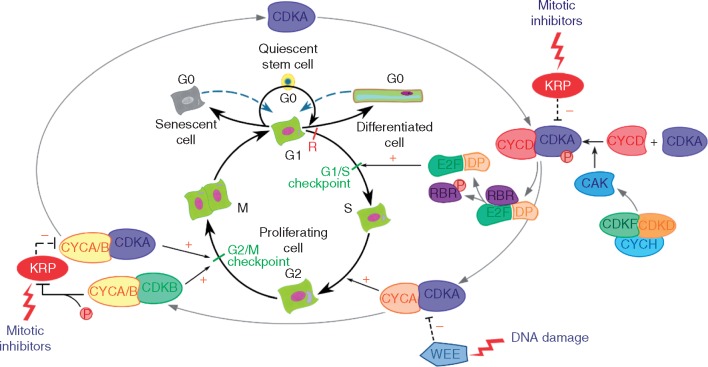Fig. 1.
Canonical cell cycle regulation in plants. The cell cycle comprises four principal phases: DNA synthesis (S), mitosis (M) and two intervening gap phases (G1, G2), plus a theoretical quiescent phase (G0). Growth-promoting factors promote formation of the CYCD/CDKA complex, which, when activated by CDKF and CDKD in association with CYCH (CAK pathway), causes phosphorylation of RBR, thus activating the E2F/DP complex, which encourages the transcription necessary to cause G1/S transition. CYCAs are synthesized during the S phase, which, in complex with CDKAs, promotes transition to G2. CYCA/B in complex with CDKA and CDKB under the regulation of the CAK pathway acts at the G2/M check-point to regulate G2/M transition. WEE1 kinase suppresses the G2/M transition in response to DNA damage. In the absence of growth-promoting conditions, cells restrict growth in G0 but resume growth when favourable conditions become available. Differentiated and/or senescent G0 cells are rarely capable of re-entering the cell cycle. In animals, it has been proposed that cells can only enter G0 prior to the restriction point (R), but after passing R are committed to the cell cycle; as yet the evidence for this restriction point is lacking in plants. Mitotic inhibitors are capable of inactivating the CYC/CDK complexes by stimulating CKIs like KRP, causing cell cycle arrest at the check-points. KRP can be inactivated by CDKB kinase activity, causing an increase in CDK activity during mitosis. + and – indicate promotion and inhibition of the pathways, respectively. For simplification, P indicates either ATP (when it is used as substrate) or phosphate (when it is linked to a molecule). CDKs, cyclin-dependent kinases; CYCs, cyclins; CKI, cyclin-dependent kinase inhibitor; KRP, kip-related proteins; RBR, retinoblastoma-related protein.

